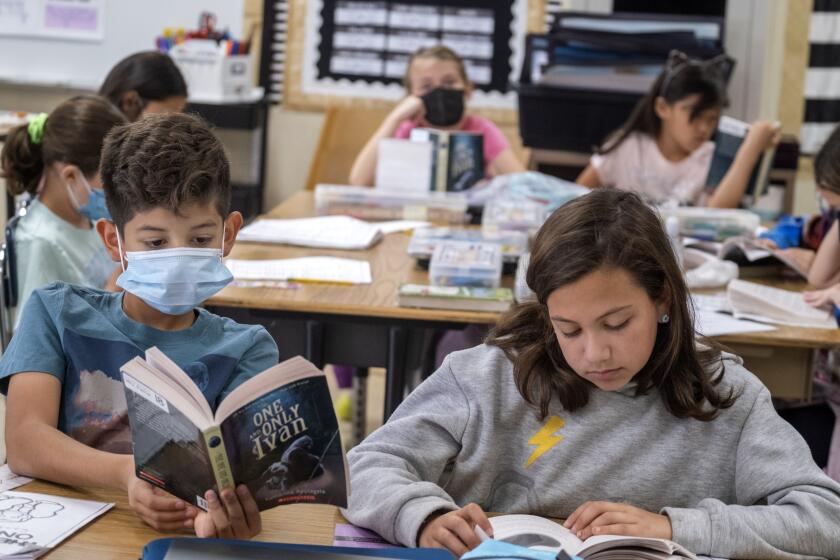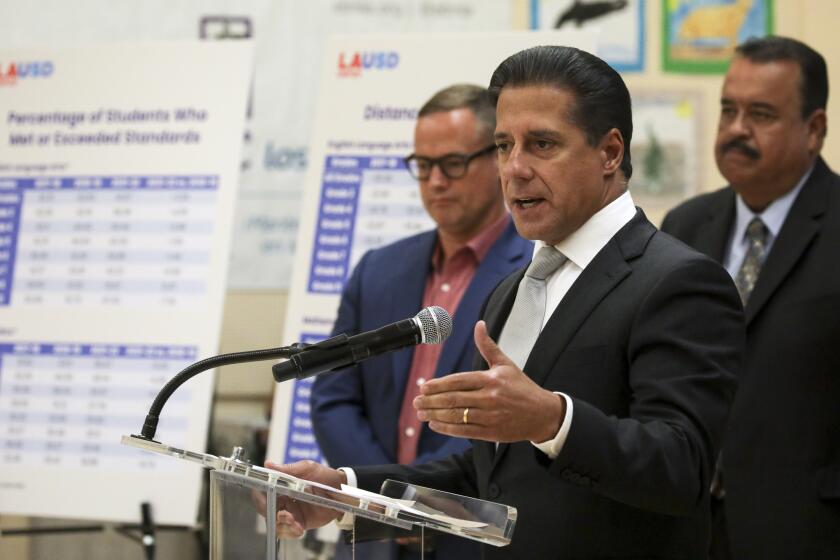Math scores plunge for America’s 13-year-olds as pandemic setbacks persist

- Share via
WASHINGTON — Math and reading scores among America’s 13-year-olds fell to their lowest levels in decades, with math scores plunging by the largest margin ever recorded, according to the results of a test known as the nation’s report card.
The results, released Wednesday, are the latest measure of the deep learning setbacks incurred during the pandemic. While earlier testing revealed the magnitude of America’s learning loss, the latest test casts light on the persistence of those setbacks, dimming hopes of swift academic recovery.
More than two years after most students returned to in-person class, there are still “worrisome signs about student achievement,” said Peggy G. Carr, commissioner of the National Center for Education Statistics, a branch of the federal Education Department.
“The ‘green shoots’ of academic recovery that we had hoped to see have not materialized,” Carr said in a statement.
2022 California test scores show 84% of Black students and 79% of Latino and low-income students did not meet state math standards.
In the national sample of 13-year-old students, average math scores fell by 9 points between 2020 and 2023. Reading scores fell by 4 points. The test, formally called the National Assessment of Educational Progress, was administered from October to December last year to 8,700 students in each subject.
Similar setbacks were reported last year when NAEP released broader results showing the pandemic’s impact on America’s fourth- and eighth-grade students.
Math and reading scores had been sliding before the pandemic, but the latest results show a precipitous drop that erases earlier gains in the years leading up to 2012. Scores on the math exam, which has been given since 1973, are now at their lowest levels since 1990. Reading scores are their lowest since 2004.
Especially alarming to officials were outsize decreases among the lowest-performing students. Students at all achievement levels saw decreases, but while stronger students saw slides of 6 to 8 points, lower-performing students saw decreases of 12 to 14 points, the results show.
The alarming dip in math proficiency and smaller declines in English in the last two pandemic-disrupted school years hit students who were already behind.
There were also differences by race. Students from almost every race and ethnicity saw math scores slide, but the steepest drops were among American Indian students, at 20 points, and Black students, at 13 points. The decline for white students, by comparison, was 6 points, while Asian students held even.
Pandemic setbacks appear to be lingering even as schools across the U.S. spend billions of dollars to help students catch up. The federal government sent historic sums of money to schools in 2021, allowing many to expand tutoring, summer classes and other recovery efforts.
But the nation’s 13-year-olds, who were 10 when the pandemic started, are still struggling, Carr said.
“The strongest advice I have is that we need to keep at it,” she said. “It is a long road ahead of us.”
Education Secretary Miguel Cardona said the results confirm what the Biden administration knew all along: “that the pandemic would have a devastating impact on students’ learning across the country and that it would take years of effort and investment to reverse the damage as well as address the 11-year decline that preceded it.”
Still, Cardona said he’s encouraged by signs of improvement elsewhere, with some states returning to pre-pandemic levels on their own math and reading assessments.
The exam is designed to measure basic skills in math and reading. Students were asked to read passages and identify the main idea or locate certain information. In math, they were asked to perform simple multiplication and tackle basic geometry, calculating, for example, the area of a square. Most questions were multiple choice.
Asked about their reading habits, fewer students than ever say they’re reading for fun every day. Just 14% reported daily reading for pleasure — which has been tied to better social and academic outcomes — down from 27% in 2012. Almost a third of students said they never or hardly ever read for fun, up from 22% in 2012.
The test also revealed a troubling increase in student absenteeism. The share of students missing five or more days of school in a month doubled since 2020, reaching 10% this year. Students with fewer missed days had higher average scores in both reading and math, according to the results.
The Associated Press education team receives support from the Carnegie Corporation of New York. The AP is solely responsible for all content.
More to Read
Sign up for Essential California
The most important California stories and recommendations in your inbox every morning.
You may occasionally receive promotional content from the Los Angeles Times.












